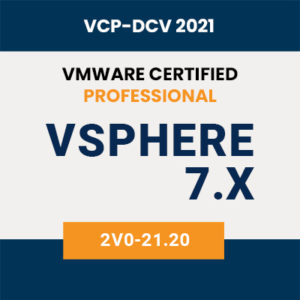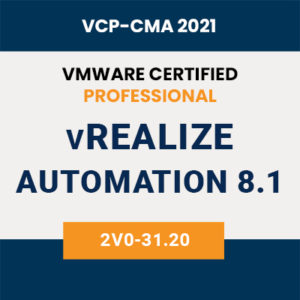Description
Exam Details (2V0-31.20)
The Professional VMware vRealize Automation 8.1 exam (2V0-31.20), which leads to the VMware Certified Professional – Cloud Management and Automation 2021 certification, is a 70-item exam (2V0-31.20) with a passing score of 300 using a scaled method. Candidates are given an appointment time of 135 minutes, which includes adequate time to complete the exam (2V0-31.20) for non- native English speakers.
Exam Delivery (2V0-31.20)
This is a proctored exam delivered through Pearson VUE. For more information, visit the Pearson VUE website.
Certification Information
For details and a complete list of requirements and recommendations for attainment, please reference the VMware Education Services – Certification website.
Minimally Qualified Candidate
The minimally qualified candidate (MQC) has 6-12 months hands-on experience installing and configuring vRealize Automation. The candidate is typically an administrator who is capable of performing a standard deployment of and managing vRealize Automation using Lifecycle Manager and troubleshooting a vRealize Automation 8.1 solution. The candidate possesses an understanding of basic cloud concepts including public/private/hybrid clouds, multitenancy, storage, networking and security. The candidate has working knowledge of each of the individual components, including Cloud Assembly Services, Service Broker, Code Stream and vRealize Orchestrator. The candidate has working knowledge of extensibility, identity and access management and basic knowledge of Kubernetes clusters and zones.
Exam Sections (2V0-31.20)
VMware exam (2V0-31.20) blueprint sections are now standardized to the seven sections below, some of which may NOT be included in the final exam blueprint depending on the exam objectives.
Section 1 – Architecture and Technologies
Section 2 – Products and Solutions
Section 3 – Planning and Designing
Section 4 – Installing, Configuring, and Setup
Section 5 – Performance-tuning, Optimization, and Upgrades
Section 6 – Troubleshooting and Repairing
Section 7 – Administrative and Operational Tasks
If a section is missing from the list below, please note it is because the exam (2V0-31.20) has no testable objectives for that section. The objective numbering may be referenced in your score report at the end of your testing event for further preparation should a retake of the exam (2V0-31.20) be necessary.
Sections Included in this Exam (2V0-31.20)
Section 1 – Architectures and Technologies
Objective 1.1 – Describe the Architecture of vRealize Automation
Objective 1.2 – Differentiate between vRealize Automation and vRealize Automation Cloud
Objective 1.3 – Describe the Services Offered by vRealize Automation
Section 2 – VMware Products and Solutions – There are no testable objectives for this section
Section 3- Planning and Designing – There are no testable objectives for this section
Section 4 – Installing, Configuring, and Setup
Objective 4.1 – Describe the Different Types of vRealize Automation deployments
Objective 4.2 – Prepare the Pre-requisites for an Installation (DNS, NTP, Service Accounts etc.)
Objective 4.3 – Perform a Standard Deployment using vRealize Easy Installer
Objective 4.4 – Configure vRealize Automation using Quickstart
Objective 4.5 – Perform Manual Installation using Lifecycle Manager
Objective 4.6 – Configure Identity Sources
Objective 4.7 – Configure Identity and Access Management
Objective 4.8 – Set up Cloud Accounts
Objective 4.9 – Add Cloud Zones
Objective 4.10 – Add Projects
Objective 4.11 – Add Image Mappings
Objective 4.12 – Add Flavor Mappings
Objective 4.13 – Add Network Profiles
Objective 4.14 – Add Storage Profiles
Objective 4.15 – Describe the Different Out of the Box Integrations Available with vRealize Automation
Objective 4.16 – Integrate vRealize Automation with vRealize Operations
Objective 4.17 – Describe the Onboarding Process
Objective 4.18 – Describe Action-Based Extensibility (ABX)
Objective 4.19 – Describe the Different Types of Tags in vRealize Automation
Objective 4.20 – Configure Capability Tags
Objective 4.21 – Configure Multi-Tenancy
Section 5 – Performance-tuning, Optimization, Upgrades – There are no testable objectives for this section
Section 6 – Troubleshooting and Repairing
Objective 6.1 – Collect Log Bundles
Objective 6.2 – Describe vracli Command Options
Objective 6.3 – Describe kubectl Command Options
Objective 6.4 – Troubleshoot vRealize Automation Configuration Errors
Objective 6.5 – Troubleshoot Provisioning Errors
Objective 6.6 – Monitor Deployments
Objective 6.7 – Monitor vRealize Orchestrator Workflow Execution
Section 7 – Administrative and Operational Tasks
Objective 7.1 – Manage the Identity and Access Management Tab
Objective 7.2 – Manage Cloud Accounts
Objective 7.3 – Manage Cloud Zones
Objective 7.4 – Manage Projects
Objective 7.5 – Manage Image Mappings
Objective 7.6 – Manage Flavor Mappings
Objective 7.7 – Manage Capability and Constraint Tags
Objective 7.8 – Manage Storage Profiles
Objective 7.9 – Manage Network Profiles
Objective 7.10 – Create and Manage Blueprints
Objective 7.11 – Create and Manage Blueprint Versions
Objective 7.12 – Manage Extensibility/Subscription
Objective 7.13 – Deploy Catalog Items
Objective 7.14 – Manage Deployments
Objective 7.15 – Describe Kubernetes Clusters
Objective 7.16 – Customize a Deployment using cloudConfig and cloud-init
Objective 7.17 – Create Service Broker Content Sources
Objective 7.18 – Configure Content Sharing
Objective 7.19 – Create and Manage Custom Forms
Objective 7.20 – Manage Policies
Objective 7.21 – Manage Notifications






